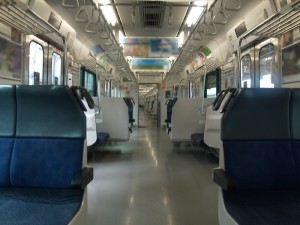Blog
Learn the secret of the safety punctuality and comfort of Japanese railways.
An Advanced Nation in Rail/ Understanding Japan's Common Sense
No.4:Superb Hospitality and Reliability in japanese Rail
Another characteristic of Japanese railways is the high quality of their overall railway services. As expressed by the word omotenashi (Japanese-style hospitality), Japan's high level of hospitality and the public trust placed in its railways distinguish Japanese railways from others across the globe. This post will look at some specific examples and how they came about.
The high level of hospitality from pre-boarding to disembarking

First, let us look at an example before boarding the train. Station facilities and operations are designed to make passenger movement as easy and efficient as possible. Detailed train traffic information is provided using digital signage and announcements, informing passengers precisely what time the train will arrive at which platform or if there are any delays. At major stations, such information is often provided in other languages, such as English and Chinese, so it may be understood by overseas visitors. Before trains depart, many train stations play short, cheerful jingles called hassha merodi (literally meaning "departure melody") to entertain passengers.
Japanese trains are also designed to be as comfortable as possible. With air conditioning and seats that are comfortable for extended sitting periods, Japan's car interiors are designed to be very pleasant. In some trains, light meals and beverages are offered, vending machines are installed, and clean toilets are made available to make long-distance trips more convenient. Japanese trains are also designed to reduce vibrations during movement. Special consideration is also given to people with physical disabilities by designing train cars so that can passengers in wheelchairs can easily board and disembark.
Operating routes have also been planned to maximize convenience. Passengers can reduce the number of transfers and time required to reach their destinations using through services, wherein trains are inter-operated in zones under the jurisdiction of other railway operators. This requires mutual arrangements between different railway operators regarding complex operations, and it is achieved by the great efforts of each operator to improve their services.
Even paying for train fares have been made more convenient by contactless smart cards. Instead of having to buy train tickets, passengers only need to directly to a ticket gate and touch the card to the sensor. The barrier will then open, and the train fare is automatically deducted. This cuts the time required to pass through ticket gates, thereby mitigating congestion. This also eliminating the need for passengers to carry change for having to calculate exact train fares. Additionally, these smart cards can also be used in other modes of transportation such as buses, as well as for paying in convenience stores, vending machines, and so on.
There are countless more examples that illustrate how Japanese railways provide high-quality services that make life easier and more convenient for ordinary passengers. All of these is an expression of the high-level of hospitality of Japanese railways. Now, we would like to ask, why have Japanese railways services developed this level of hospitality?
Why Japanese railway operators have prioritized hospitality

Yosuke Nakazawa
Technology Executive of Railway Systems Division at Toshiba Corporation Infrastructure Systems & Solutions Company
Yosuke Nakazawa, Technology Executive of Railway Systems Division at Toshiba Corporation Infrastructure Systems & Solutions Company, , provided an insight on the situation in Japan. He said, "It is inevitable that there would always be inconveniences to railway passengers, such as not being able to sit during peak hours, especially in Japan. Railway companies understand the daily burden of the passengers, and this drives them to provide more comfort for such passengers as much as possible. I think that this concern for the comfort of riders has, in effect, increased the level of these services."
In addition, Japan is a mountainous country with many rugged areas. Due to its geography, it is difficult to build more tracks and other infrastructure that could have been used to create more railway routes. But railway companies have had no choice but to operate more trains in short intervals of time to increase transport volumes. Yet, in spite of all the inconveniences and limitations, Japanese railways have consistently considered passenger comfort, prioritizing hospitality from pre-boarding to disembarkation. This is because Japanese railway operators to provide railways not only as a mere mode of transportation, but rather go beyond it by constantly striving to provide more comfortable and efficient services that exceed the expectations of the normal passenger.
Japan's cultural and geographical background has led to the development of the high-grade hospitality, operating in synergy with factors such as punctuality and safety to improve rider satisfaction. This is how Japanese railways have maintained a high level of trust until today. These factors are all closely connected; if just one of them were missing, Japanese railways might not be so highly praised across the world today.
Over the last four posts we have discussed the current state of Japanese railways in detail. Next, we will give an overview of how the transit plans that support Japanese railways are made.



